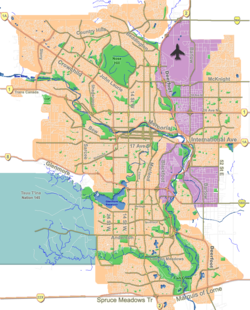Tower Centre | ||||||||||||||||||||||||||||||||||||
|---|---|---|---|---|---|---|---|---|---|---|---|---|---|---|---|---|---|---|---|---|---|---|---|---|---|---|---|---|---|---|---|---|---|---|---|---|
 A Via Rail train at the station in 1982 | ||||||||||||||||||||||||||||||||||||
| General information | ||||||||||||||||||||||||||||||||||||
| Location | 131 9 Ave SW, Calgary, Alberta | |||||||||||||||||||||||||||||||||||
| Coordinates | 51°02′39″N114°03′47″W / 51.0441°N 114.0631°W | |||||||||||||||||||||||||||||||||||
| Owned by | Aspen Properties | |||||||||||||||||||||||||||||||||||
| Construction | ||||||||||||||||||||||||||||||||||||
| Structure type | Underground | |||||||||||||||||||||||||||||||||||
| Parking | 1,403 above ground stalls [1] | |||||||||||||||||||||||||||||||||||
| Other information | ||||||||||||||||||||||||||||||||||||
| Status | Disused | |||||||||||||||||||||||||||||||||||
| Website | www | |||||||||||||||||||||||||||||||||||
| History | ||||||||||||||||||||||||||||||||||||
| Opened | May 1969 (as Canadian Pacific Railway station) | |||||||||||||||||||||||||||||||||||
| Closed | January 1990 (as Via Rail station) | |||||||||||||||||||||||||||||||||||
| Previous names | ||||||||||||||||||||||||||||||||||||
| Former services | ||||||||||||||||||||||||||||||||||||
| ||||||||||||||||||||||||||||||||||||
| ||||||||||||||||||||||||||||||||||||
Tower Centre in Calgary, Alberta, Canada, is an office tower and retail centre connected to the Calgary Tower. It is only three minutes on foot from the CTrain's 1 Street SW station and Centre Street station. It was called Palliser Square from its opening in 1969 until the name was changed to Tower Centre in November 1989. [2] [3] Since 2003, Tower Centre has also been the home of Vertigo Theatre.



